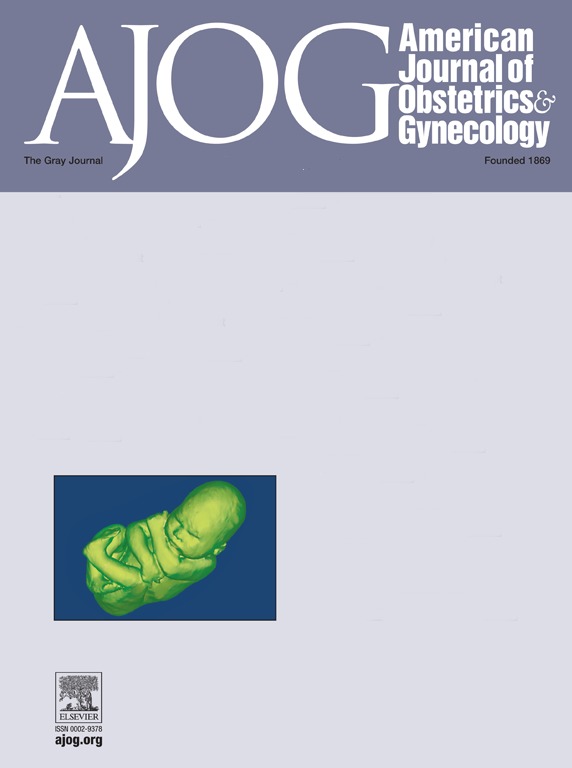一项3期、多中心、随机、安慰剂对照试验,每月口服ibrexafungerp以减少复发性外阴阴道念珠菌病的发生率。
IF 8.4
1区 医学
Q1 OBSTETRICS & GYNECOLOGY
引用次数: 0
摘要
背景:5-9%出生时被指定为女性的人患有复发性外阴阴道念珠菌病,严重影响生活质量。ibrexafungerp口服ibrexafungerp是美国批准的一类非唑类三醇类抗真菌药物,用于治疗月经后女性急性外阴阴道念珠菌病,并降低外阴阴道念珠菌病复发的发生率。目的(S):这项3期研究(CANDLE)描述了每月口服ibrexafungerp与安慰剂在降低外阴阴道念珠菌病复发发生率方面的疗效和安全性。研究设计:有复发性外阴阴道念珠菌病急性感染史(经氢氧化钾试验阳性证实)的参与者接受3剂口服氟康唑(150mg,每3天一次)。筛选样本中有培养证实的外阴阴道念珠菌病,经氟康唑治疗后症状和体征显著缓解(外阴阴道症状和体征综合评分≤2分),并继续符合所有研究资格标准的患者进入维持期。在维持期,符合条件的参与者被随机分配(1:1)口服ibrexafungerp (300 mg,每日两次,1天)或安慰剂,每4周重复一次,共6次治疗(直到第20周)。通过无真菌学证实复发的参与者的百分比和临床成功的参与者的百分比来评估疗效(通过治愈试验[第24周]评估且无复发的参与者;通过治愈试验(最后一次研究药物剂量后4周)证实(真菌学证明,推测或怀疑)。安全性和耐受性评估包括不良事件的发生率和治疗中断。在12周的随访期间,进一步评估参与者的复发情况。结果在意向治疗人群中,70.8% (n=92/130)接受ibrexafungerp治疗的患者和58.5% (n=76/130)接受安慰剂治疗的患者通过治愈试验没有真菌学证实的复发(相对风险:1.22;95%置信区间:1.032,1.430;P = 0.019)。通过治愈试验获得临床成功的参与者比例,ibrexafungerp组为65.4% (n=85/130),安慰剂组为53.1% (n=69/130)(相对风险:1.24;95%置信区间:1.034,1.486;P = 0.020)。ibrexafungerp在最后一次研究药物剂量后的4个月内持续优于安慰剂,无真菌学证实的复发(65.4% [n=85/130] vs 53.8% [n=70/130];相对风险:1.22;95%置信区间:1.021,1.456;P=0.029)和临床成功率(57.7% [n=75/130] vs 46.2% [n=60/130]);相对危险度:1.26;95%置信区间:1.017,1.555;P = 0.034)的端点。总体而言,64.6% (n=84/130)接受ibrexafungerp治疗的参与者和58.5% (n=76/130)接受安慰剂治疗的参与者经历了≥1次治疗后出现的不良事件。ibrexafungerp组14.6% (n=19/130)的受试者发生治疗相关不良事件,安慰剂组6.9% (n=9/130)的受试者发生治疗相关不良事件。ibrexafungerp组无不良事件导致治疗或研究中止。在ibrexafungerp组和安慰剂组中报告的最常见不良事件是头痛、细菌性阴道病和腹泻;这些事件的严重程度大多较轻。结论对复发性外阴阴道念珠菌病患者,每月一次口服依布雷沙芬格普是有效且耐受性良好的。本文章由计算机程序翻译,如有差异,请以英文原文为准。
A Phase 3, multicenter, randomized, placebo-controlled trial of monthly oral ibrexafungerp to reduce the incidence of recurrent vulvovaginal candidiasis.
BACKGROUND
Recurrent vulvovaginal candidiasis develops in 5-9% of people assigned female at birth and has a serious impact on quality of life. Oral ibrexafungerp is a first-in-class, non-azole, triterpenoid antifungal approved in the United States for the treatment of postmenarchal females with acute vulvovaginal candidiasis and for the reduction in the incidence of recurrent vulvovaginal candidiasis.
OBJECTIVE
(S): This Phase 3 study (CANDLE) describes the efficacy and safety of monthly oral ibrexafungerp vs placebo for reducing the incidence of recurrent vulvovaginal candidiasis.
STUDY DESIGN
Participants with a history of recurrent vulvovaginal candidiasis experiencing an acute infection episode (confirmed by positive potassium hydroxide test) received 3 doses of oral fluconazole (150 mg once-daily every 3 days). Those who had a culture-confirmed vulvovaginal candidiasis from the screening sample, achieved significant resolution of signs and symptoms (composite Vulvovaginal Signs and Symptoms score ≤2) following fluconazole treatment, and continued to meet all study eligibility criteria entered a maintenance phase. In the maintenance phase, eligible participants were randomized (1:1) to oral ibrexafungerp (300 mg twice-daily for one day) or placebo, which was repeated once every 4 weeks for a total of 6 treatments (until Week 20). Efficacy was assessed by the percentage of participants with no mycologically-proven recurrence and the percentage of participants with clinical success (a participant with a Test-of-Cure [Week 24] evaluation and no recurrence; mycologically-proven, presumed, or suspected) by Test-of-Cure (4 weeks after last study drug dose). Safety and tolerability assessments included incidence of adverse events and treatment discontinuations. Participants were further assessed for recurrence during a 12-week follow-up phase.
RESULTS
In the intent-to-treat population, 70.8% (n=92/130) of participants who received ibrexafungerp and 58.5% (n=76/130) who received placebo had no mycologically-proven recurrence by Test-of-Cure (relative risk: 1.22; 95% confidence interval: 1.032, 1.430; P=0.019). The proportion of participants who achieved clinical success by Test-of-Cure was 65.4% (n=85/130) with ibrexafungerp and 53.1% (n=69/130) with placebo (relative risk: 1.24; 95% confidence interval: 1.034, 1.486; P=0.020). The benefit of ibrexafungerp over placebo was sustained over the 4 months following last study drug dose for both the no mycologically-proven recurrence (65.4% [n=85/130] vs 53.8% [n=70/130]; relative risk: 1.22; 95% confidence interval: 1.021, 1.456; P=0.029) and clinical success (57.7% [n=75/130] vs 46.2% [n=60/130]; relative risk: 1.26; 95% confidence interval: 1.017, 1.555; P=0.034) endpoints. Overall, 64.6% (n=84/130) of participants who received ibrexafungerp and 58.5% (n=76/130) of participants who received placebo experienced ≥1 treatment-emergent adverse event. Treatment-related adverse events occurred in 14.6% (n=19/130) of participants in the ibrexafungerp group and 6.9% (n=9/130) of participants in the placebo group. No adverse events in the ibrexafungerp group led to treatment or study discontinuation. The most common adverse events reported in both the ibrexafungerp and placebo groups were headache, bacterial vaginosis, and diarrhea; these events were mostly mild in severity.
CONCLUSION
Once-monthly oral ibrexafungerp was effective and well-tolerated in participants with recurrent vulvovaginal candidiasis.
求助全文
通过发布文献求助,成功后即可免费获取论文全文。
去求助
来源期刊
CiteScore
15.90
自引率
7.10%
发文量
2237
审稿时长
47 days
期刊介绍:
The American Journal of Obstetrics and Gynecology, known as "The Gray Journal," covers the entire spectrum of Obstetrics and Gynecology. It aims to publish original research (clinical and translational), reviews, opinions, video clips, podcasts, and interviews that contribute to understanding health and disease and have the potential to impact the practice of women's healthcare.
Focus Areas:
Diagnosis, Treatment, Prediction, and Prevention: The journal focuses on research related to the diagnosis, treatment, prediction, and prevention of obstetrical and gynecological disorders.
Biology of Reproduction: AJOG publishes work on the biology of reproduction, including studies on reproductive physiology and mechanisms of obstetrical and gynecological diseases.
Content Types:
Original Research: Clinical and translational research articles.
Reviews: Comprehensive reviews providing insights into various aspects of obstetrics and gynecology.
Opinions: Perspectives and opinions on important topics in the field.
Multimedia Content: Video clips, podcasts, and interviews.
Peer Review Process:
All submissions undergo a rigorous peer review process to ensure quality and relevance to the field of obstetrics and gynecology.

 求助内容:
求助内容: 应助结果提醒方式:
应助结果提醒方式:


